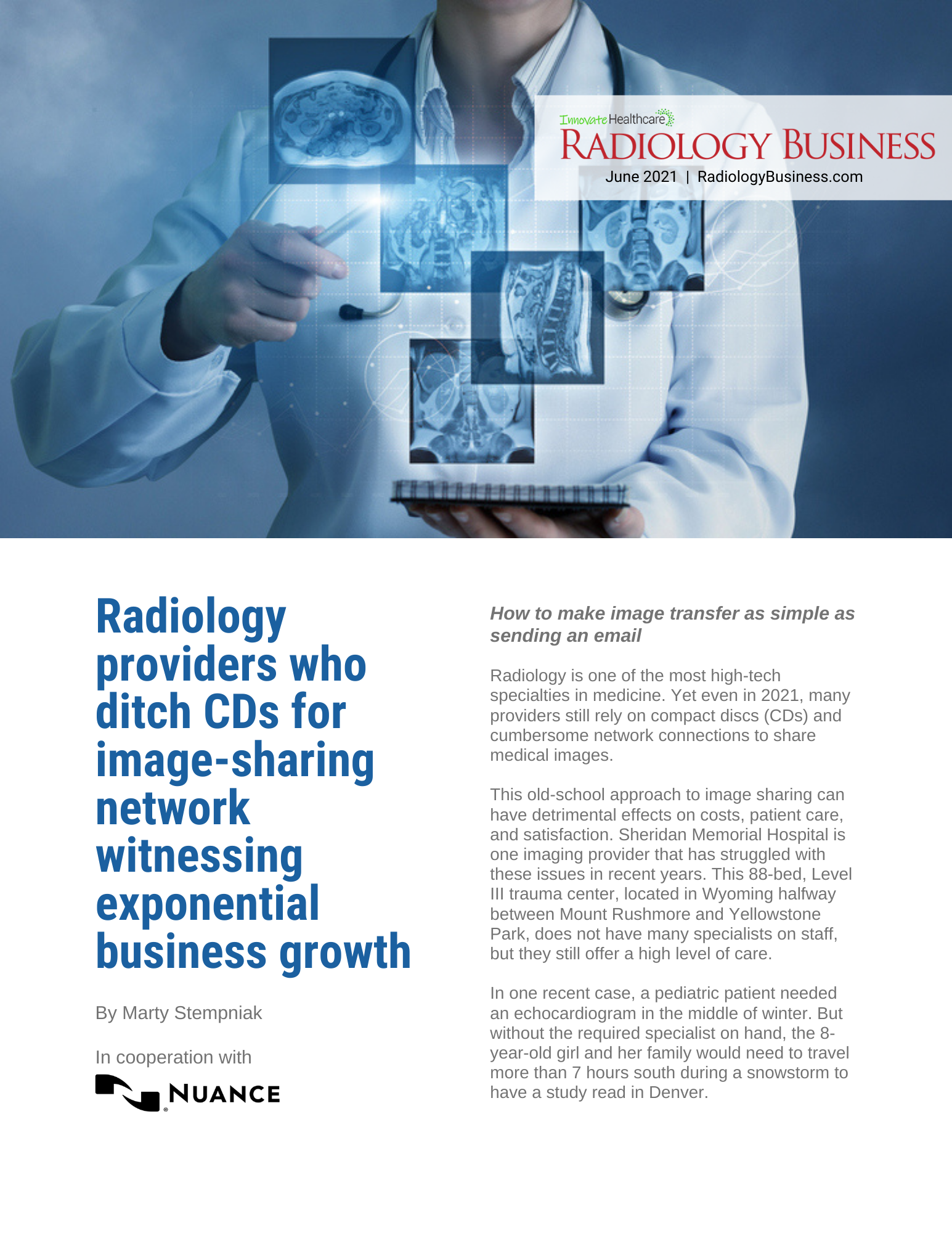Radiology providers who ditch CDs for image-sharing network witnessing exponential business growth
How to make image transfer as simple as sending an email
Radiology is one of the most high-tech specialties in medicine. Yet even in 2021, many providers still rely on compact discs (CDs) and cumbersome network connections to share medical images.
This old-school approach to image sharing can have detrimental effects on costs, patient care, and satisfaction. Sheridan Memorial Hospital is one imaging provider that has struggled with these issues in recent years. This 88-bed, Level III trauma center, located in Wyoming halfway between Mount Rushmore and Yellowstone Park, does not have many specialists on staff, but they still offer a high level of care.
In one recent case, a pediatric patient needed an echocardiogram in the middle of winter. But without the required specialist on hand, the 8-year-old girl and her family would need to travel more than 7 hours south during a snowstorm to have a study read in Denver.
Chris Bilyeu, Sheridan Memorial’s radiology manager since 1997, recalls other occasions of spending $50 to mail 25 cent CDs, hoping that the mail carrier would get this precious medical information to its final destination. Often, providers would perform an imaging exam again if a disc was corrupted or incompatible, exposing patients to unnecessary excess radiation and costs. Other days, Bilyeu would have to wait a week to set up a virtual private network to transmit studies.
“Every time I requested a VPN through the IT department, the first response was a groan,” he says. “It was just a time-consuming and cumbersome process. I would get anxiety whenever someone asked for a connection.”
But two years ago, Sheridan Memorial Hospital found a better way, switching over to Nuance PowerShare Image Sharing to easily view, share and manage medical images with patients and other outside institutions. Now it takes just moments with a single click via the cloud-based system.
“Our ultimate goal is to do away with CDs completely,” Bilyeu says, estimating that Sheridan has already reduced compact disc use by about 50% since 2019. “It’s a slow evolution. Many physicians are old school and still want a physical copy to input into their PACS. Increased awareness needs to happen before this completely takes off.”
Looking at the numbers
Advocates in the image-sharing community such as Nuance are trying to build such awareness and knowledge across imaging. Some of the potential cost savings are eye-opening. One study estimated that providers repeat nearly 8% of imaging tests within 90 days, a number that dropped significantly with image enabled health info exchange. Another analysis from Weill Cornell Medicine found that electronic exchange of images could save their institution more than $32,000 annually or $2.57 per patient. More than half of physicians say access to outside records would help curb overtreatment.
Beyond the financial considerations are improvements to patient care and satisfaction. Individuals transferred for trauma services without their imaging exams can experience lengthy and even risky care delays, while those involved in one image-sharing initiative expressed greater contentment with their care.
COVID-19 has only intensified radiology providers’ need to exchange images electronically. New York City hospital giant Northwell Health and its radiologists were mobilized as part of a makeshift field hospital in the Javits Convention Center in March 2020. With 1,200 beds and an army of X-ray and ultrasound machines, the hospital’s rads were able to stay remote to read exams in real-time, thanks to the flexibility of PowerShare.
On a smaller scale, Morris County Hospital in Council Grove, Kansas, was challenged in transferring patients who required higher levels of care than it could deliver. Occasionally, the 32-bed critical access hospital’s clinicians would need to reroute patients to alternate locations at the last minute if the first option lacked available beds. Having the flexibility to resend studies to the correct place was “essential,” recalls Radiology Director Veronica Messer.
With a small staff of just five employees in its radiology department that complete about 6,000 imaging procedures a year, they rely on off-site radiologists to read their exams. Sharing or accessing images as easily as managing email allows Messer and colleagues to avoid disc handoffs that would potentially put team members in harm’s way. “We’re a small staff and could have easily been wiped out if COVID got in the building,” she says.
PowerShare is even helping Morris County, located in Eastern Kansas’ Flint Hills, to attract and treat new patients. A resident who developed brain cancer didn’t have to make the three-hour trip to Kansas City for an MRI procedure. Instead, the local hospital team performed the scan and shared or “Nuanced it,” as they say, with a radiologist 100-plus miles away for interpretation. Physicians have become more comfortable sending their patients to Morris County for imaging because of this option, Messer notes.
“Providers know they’ll be able to get the information and report quickly,” she says. “The program is worth its weight in gold. I don’t have any issues with people calling anymore saying they can’t load a disc or the images aren’t there. We used to spend so much time and money on mailers and overnighting things. PowerShare more than makes up for that, but most of all, it is exceptional for patient care.”
Nuance estimates that moving to PowerShare has helped its clients reduce CD usage by 80%, cutting image-processing costs by 64%. Unnecessary repeat scans dip on average by about 40%, while the time to intervention falls about 74%. Currently, the product is used across more than 9,000 connected facilities by physicians who read millions of studies each year.
Beyond radiology
Healthcare institutions, large and small, find that the image-sharing platform’s value extends well beyond radiology to many other specialties. Use cases include everything from sharing photos and images for presurgical consults to treatment planning for radiation oncology, dermatology and wound care collaboration or prepping for a trauma patient’s arrival.
Hemet Global Medical Center in California—a PowerShare user since 2019—sometimes has to transfer pediatric patients to specialized centers nearby for inpatient procedures. In one case before the switchover, an outside surgeon needed to see a brain CT before determining if he could treat the child. PACS Administrator Gene Reiver recalls having to text the physician a cellphone picture of the medical images, cropping out any personal information, before making the transfer. Far from ideal. Another time, an orthopedic surgeon had to drive across town to get a patient’s images to deduce whether a bone repair procedure was possible.
In 2021, however, such errands are a distant memory. If surgeons require information from the 327-bed hospital, it can set up outside providers as “instant end users,” regardless of whether they’re Nuance customers. Hemet can electronically transport patient information in as quickly as five minutes.
They’re currently considering expanding use into other “ologies” such as cardiology and interventional cardiology and allowing unit secretaries to have access to smooth outpatient transfers.
“We have been talking about this for a while, but things got put on hold because of COVID, and we haven’t gone down that exploratory road yet,” Reiver says.
Image sharing is helping large organizations, too. The 1,010-bed Tampa General Hospital has built a sophisticated, highly specialized program using PowerShare to treat aortic emergencies. These cases can be life-threatening if not diagnosed and addressed quickly and require the initiation of a complex care team at a Level 1 trauma center to plan surgical intervention.
In a recent example, paramedics found a male patient unconscious, pale, and diaphoretic at his home. He was transported to South Florida Baptist Hospital’s emergency department, where a CT angiogram of his chest, abdomen, and pelvis showed he suffered an aortic aneurysm. They knew right away he would have to be transported for surgery.
Tampa General had a comprehensive policy in place for cases like this. Providers could quickly send the CT images for review, as the aortic team and vascular surgeon were alerted. Mr. E, as they referred to the patient, arrived within 10 minutes. Surgeons operated for five hours and saved the patient.
Aortic Program Coordinator Marcelo Giarelli, RN, says PowerShare has helped the institution eliminate geographic care hurdles and become a national leader in the field by having swift access to images electronically. They’ve gradually built their reputation far and wide, with patients traveling from South America and the Virgin Islands to tap their expertise.
“We can do a telehealth visit with someone anywhere in the world; PowerShare has eliminated the boundaries,” Giarelli says. “From a business perspective, Nuance can help you as a center to expand your services exponentially.”


